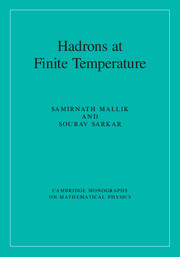Book contents
- Frontmatter
- Dedication
- Contents
- Preface
- Notation
- 1 Free Fields in Vacuum
- 2 Spontaneous Symmetry Breaking
- 3 Chiral Perturbation Theory
- 4 Thermal Propagators
- 5 Thermal Perturbation Theory
- 6 Thermal Parameters
- 7 Two-Loop Results
- 8 Heavy Ion Collisions
- 9 Non-Equilibrium Processes
- Appendix A General Fields
- Appendix B Global Symmetries
- Appendix C Exponential Operator
- Appendix D Propagator at Origin of Coordinates
- Appendix E Reaction Rates in Vacuum and Medium
- Appendix F Coupling Constants
- Appendix G Imaginary Time Method
- Appendix H Quark Condensate from Partition Function
- Appendix I Quark Condensate from Density Expansion
- Index
Preface
Published online by Cambridge University Press: 27 October 2016
- Frontmatter
- Dedication
- Contents
- Preface
- Notation
- 1 Free Fields in Vacuum
- 2 Spontaneous Symmetry Breaking
- 3 Chiral Perturbation Theory
- 4 Thermal Propagators
- 5 Thermal Perturbation Theory
- 6 Thermal Parameters
- 7 Two-Loop Results
- 8 Heavy Ion Collisions
- 9 Non-Equilibrium Processes
- Appendix A General Fields
- Appendix B Global Symmetries
- Appendix C Exponential Operator
- Appendix D Propagator at Origin of Coordinates
- Appendix E Reaction Rates in Vacuum and Medium
- Appendix F Coupling Constants
- Appendix G Imaginary Time Method
- Appendix H Quark Condensate from Partition Function
- Appendix I Quark Condensate from Density Expansion
- Index
Summary
This book is an elementary introduction to hadronic properties at finite temperature (and chemical potential). Its contents may be divided into three parts.
The first part, comprising the first three chapters, develops the (vacuum) theory of hadronic interactions at low energy. As propagators play a major role in applications, we review in Chapter 1 in detail the vacuum propagators for fields of different spins. This provides the background in which to discuss later (in Chapter 4) the form of thermal propagators. The next two chapters are devoted to strong interaction dynamics. Chapter 2 describes the phenomenon of spontaneous symmetry breaking leading to Goldstone bosons. It prepares the ground for chiral perturbation theory in Chapter 3. We review this theory in some detail, including Goldstone as well as (heavy) non-Goldstone fields interacting with the Goldstone fields. Chapters 2 and 3 constitute an elementary yet general introduction to the effective theory of strong interactions at low energy.
The second part consists of the next two chapters and presents the equilibrium thermal field theory. Broadly speaking, there are two formulations of this theory, concerning so-called real and imaginary time. Though the imaginary time formulation is used more often than that of real time, we choose the latter in this book and try to show some of its advantages. In Chapter 4 we derive in elementary ways the thermal matrix propagators for fields of low spin and go on to obtain the spectral representation of complete propagators for fields of arbitrary spin. In Chapter 5 the thermal perturbation theory is developed in relation to the matrix structure of the propagators.
The third part consists of the last four chapters. Here we apply the methods developed to study different thermal one- and two-point functions in the hadronic phase using chiral perturbation theory. In Chapter 6 we obtain the temperature dependence of a number of hadronic parameters to one loop. Some two-loop results are presented in Chapter 7. In Chapter 8 we derive the dilepton cross-section measured in heavy ion collisions. Finally, Chapter 9 describes the (non-equilibrium) transport phenomenon, whose discussion can be reduced to fluctuations in thermal equilibrium. Clearly the range of applications of thermal field theory in particle physics is much wider. Many such applications are covered in books (mentioned in Chapter 4), though mostly in imaginary time formulation.
- Type
- Chapter
- Information
- Hadrons at Finite Temperature , pp. xiii - xivPublisher: Cambridge University PressPrint publication year: 2016



